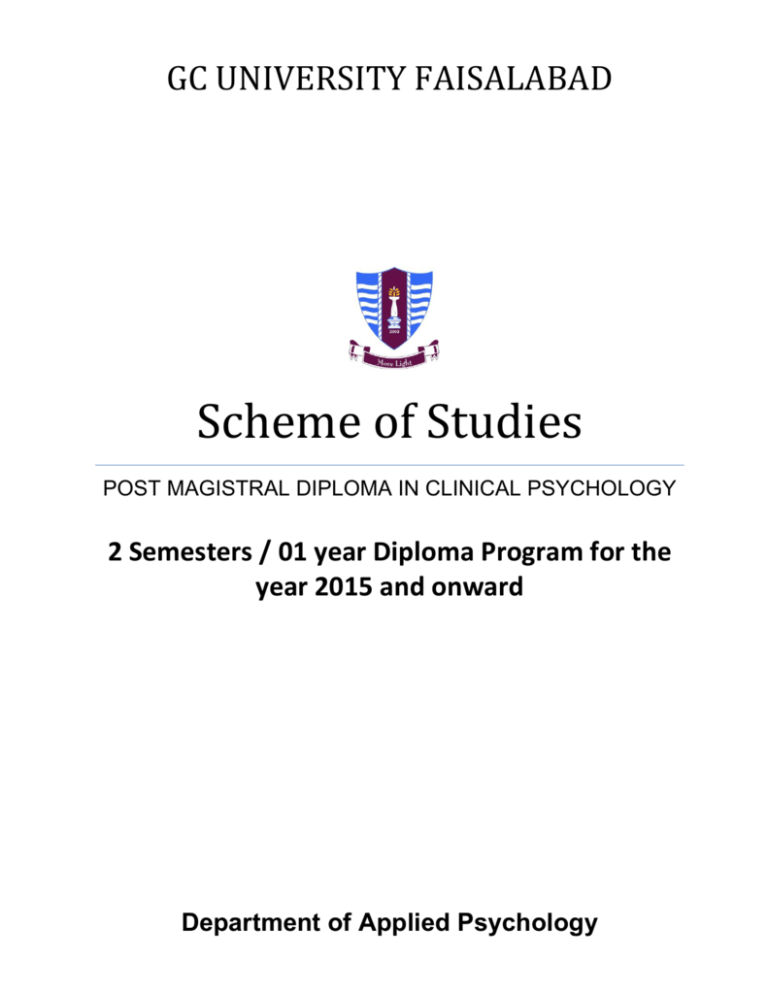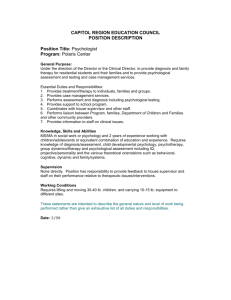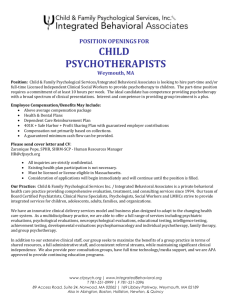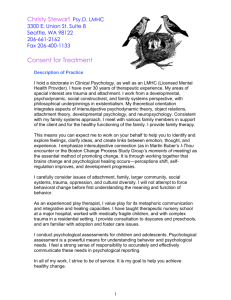
GC UNIVERSITY FAISALABAD
Scheme of Studies
POST MAGISTRAL DIPLOMA IN CLINICAL PSYCHOLOGY
2 Semesters / 01 year Diploma Program for the
year 2015 and onward
Department of Applied Psychology
Scheme of Studies PMDCP
POST MAGISTRAL DIPLOMA IN Clinical Psychology
OUTLINE OF CORE COURSES FOR PMD IN
CLINICAL PSYCHOLOGY
Course
Course Title
Code
Credit
Hours
Semester – I
C. Psy-801
Research Methodology and Statistics in
04(3-1)
Clinical Psychology-I
C. Psy-802
Psychodiagnosis and Assessment-I
03
C. Psy-803
Psychotherapy –I
03
C. Psy-804
Psychophysiology & Psychopharmacology-I
03
C. Psy-805
Internship
04
Total
17
Semester – II
C. Psy-811
Research Methodology and Statistics in
04(3-1)
Clinical Psychology-II
C. Psy-812
Psychodiagnosis and Assessment-II
03
C. Psy-813
Psychotherapy –II
03
C. Psy-814
Psychophysiology & Psychopharmacology-II
03
C. Psy-815
Internship
04
Total
17
Summer Semester
C. Psy-810
Internship
G. Total
04
38
2
GC University, Faisalabad
Scheme of Studies PMDCP
Eligibility Criteria for Post Magistral Diploma Leading in
Clinical Psychology
Duration: One year
Post Magistral Diploma (PMD), consisting of two Semesters and one
Summer Semester of 8 weeks (only for Internship).
Eligibility for Admission in PMD. M.A / M.Sc/ BS Hons (4 years)
(minimum second class) in Psychology and its allied fields/equivalent,
from a Recognized University. Candidates will have to go through the
Academic and personality assessment and interview.
Eligibility for Award of Post Magistral Diploma (Duration 1 year)
Successful completion of a total of 38 Credit Hours [(26 Credit Hours of
course work and 12 Credit Hours of Internship (minimum of 100
Psychotherapy sessions/hours (recorded) and 10 Psychodiagnostic
Reports)].
SEMESTER 1st
Name of Course
RESEARCH METHODOLOGY AND STATISTICS IN
CLINICAL PSYCHOLOGY-I
Clinical. Psy. 801
Credit Hours
04(3-1)
Objectives
The course designed to familiarize the students with all aspects of
research processes from generation of research idea to data collection,
analysis, and interpretation of findings.
The course also aims to develop scientific reasoning and understating of
link between theory and empirical investigation
CONTENTS
3
GC University, Faisalabad
Scheme of Studies PMDCP
Introduction
o Definition and importance of research
o Scientific and Ethical Foundations of Research
o Scientific and non-scientific methods
Types of research
o Quantitative and Qualitative Research
o Basic and applied research
o phenomenological
Research Designs and types of Research Design
o Experimental Research Design
o Corelational Research Design
o Longitudinal and cross sectional Research Design
o Case study methods
Theory and Hypotheses Evaluation in Research
Subject Selection and Sampling
o Probability and non probability sampling
o Advantages and disadvantages of each type
Methods of data collection
o The Interview,
o Questionnaires
o Observation
o Content Analysis,
Test/Questionnaire Construction
Measurement,
o Types of measurement
o Reliability and validity
o Measurement scales
o Scaling Methods
Dichotomous scales
Guttman scale
Likert scale
Thuston scale
Research in Psychotherapy
Ethical Issues in Research,
o APA codes of ethics
o APA report writing
Practical
o Students will write a Research Report.
BOOKS RECOMMENDED
Barker, Chris and Pitsrang, Nancy (1994) Research methods in Clinical and Counseling
Psychology. John Wiley and Sons.
4
GC University, Faisalabad
Scheme of Studies PMDCP
Bean, M. L. (1954) Construction of Educational and Personnel tests. McGraw Hill, New York.
Clark-Carter, D. (2004). Quantitative psychological research: A student’s handbook. New York:
Psychology Press.
Davis, S. F., & Smith, R. A. (2005). An introduction to statistics and research methods:
becoming a psychological detective. New Jersey: Pearson Prentice Hall.
Elmes, D.G., Kantowitz, H.L., & Roediger, H.L. (2003). Research methods in psychology (7th
ed.). Belmont: Wadsworth/Thomson Learning.
Fisher, R.A. (1950)Statistical Methods for Research Workers. Oliver Boyd, Edinburg.
Friedman, N. (1968) The Social Nature of Psychological Research. Basic Books, New
York.
Hymen, H., Cobb, W, Feldman, J., Hart, C., and Stember, C.H.( 1954) Interviewing in
Social Research.
University of Chicago Press, Chicago.
Jacobs,O. A (1970) Guide for Developing Questionnaire Items. National Technical
Information Service, U.S. Department of Commerce Springfield, Va.
Kerlinger, F.N., & Lee, H.B. (2000). Foundations of behavioral research (4th ed.). Belment:
Wadsworth/Thomson Learning.
Lewin, M. (1979) Understanding Psychological Research. John Wiley & sons Inc. New York.
Mook, D.G. (2001). Psychological research: the ideas behind the methods. New York:
W.W.
Norton & Company.
Roberts, M.C., & Ilardi, S. S. (2003). Handbook of research methods in clinical psychology.
Oxford: Blackwell Publishing.
Shaughnessy, J.J., Zechmeister, E.B., & Zechmeister, J.S. (2000). Research methods in
psychology (5th ed.). New York: McGraw-Hill.
Plutchik, R. (1974). Foundation of Experimental research. (2nded). Harper & Row, New York,
Name of Course
PSYCHODIAGNOSIS AND ASSESSMENT-I
Clinical. Psy. 802
Credit Hours
03
Objectives
To introduce the students to the basic theoretical psychometric concepts
and use of psychological tests.
Main course objectives include understanding of the basic principles of
psychological measurement and the techniques of test construction,
administration, and validation. Test rationale, construction, characteristics
and the use of evaluation are emphasized.
To understand assessment and evaluation of individuals, groups, and
specific populations.
CONTENTS
Introduction
o What is Psychodiagnosis
o Importance of Psychodiagnosis & Assessment
5
GC University, Faisalabad
Scheme of Studies PMDCP
o Definition, nature, uses and limitations of Assessment
o Importance of Assessment
o Modes of Assessment
Diagnosis and Use of DSM IV TR
o Multi-Axial System
o Substances-related disorders
o Disorders usually first diagnosed in Infancy, Childhood and
Adolescence
o Schizophrenia & other Psychotic disorders
o Mood Disorders
o Somatoform Disorders
o Factitious Disorders
o Anxiety Disorders
o Dissociative Disorders
o Sexual and Gender Identity Disorders
o Eating Disorders
o Impulse-Control Disorders
o Sleep Disorders
o Adjustment Disorders
o Delirium, Dementia, Amnesia and other Cognitive Disorders
o Personality Disorders
Clinical Interviewing
o Types of Interview
o Psychometric Aspects of Interview
o Cultural Aspects of the interview
o Case History Data
Administration, Scoring, Interpretation of Psychological Tests
o Neuropsychological Tests.
o Intelligence Tests
o Personality Tests
6
GC University, Faisalabad
Scheme of Studies PMDCP
o Achievement & Vocational Tests
o Ability & Aptitude Tests
BOOKS RECOMMENDED
Butcher, J. (1979) New Developments in use of the MMPI. University of Minnesota Press,
Minneapolis.
Colby, K. A. (1951). Primer for Psychotherapists. John Wiley & sons,
New York.
Cole, M and Scribner, S. (1974). Culture and Thought. John Wiley & sons, New York.
Dahlstrom, W. and Dahlstrom, L. (1980). Basic Reading on the MMPI. University of
Minnesota
Press, Minneapolis.
Dahlstrom, Wand Welsh, G. (1982) An MMPI Handbook. University of Minnesota Press,
Minneapolis.
Diagnostic Statistical manual (IV). American Psychiatric Association Washington.
Fromrn Reich man, F. (1950). Principles of Intensive Psychotherapy. The University
Chicago
Press, Chicag.
Gambrills, E. (1978). Behavior Modification: Handbook of Assessment, Intervention and
Evaluation. Jossey- Bass, California.
Golden, C. (1981). Prognosis and Rehabilitation in Clinical Neuropsychology. Charles C.
Thomas, lIIinois.
Goosdenough, F. (1926). The measurement of Intelligence by Drawing. World Books
Company,
New York.
Groth-marnat, G. (2005). Handbook of psychological assessment (4th ed.). New Jersey: John
Wiley & Sons.
Hutt. S.J. (1970). Direct Observation and measurement of behavior Charles C. Thomas, Pub.
Illinois.
Plante, T.G. (2005). Contemporary Clinical Psychology (2nd ed.). New Jersey: John Wiley &
Sons.
Name of Course
PSYCHOTHERAPY -I
Clinical. Psy. 803
Credit Hours
03
Objectives
To understand and change the abnormal behavior, cognition, and
emotions through the application of psycho-therapeutic principles and
techniques
To equip the students with a strong knowledge, skill and acumen in the
detection, evaluation and diagnosis of various psychological conditions
CONTENTS
Introduction to Psychotherapy
o Definition, scope and aims of psychotherapy
7
GC University, Faisalabad
Scheme of Studies PMDCP
o Goals and limitations of psychotherapy
o types and classification of psychotherapy (supportive, re-educative &
reconstructive psychotherapy)
o Variables affecting the process of psychotherapy
o Do’s and Don’ts of psychotherapy
Personality and Psychotherapy
o Gender and Psychotherapy
o Qualities of a good psychotherapist
Patient and Psychotherapist needs and expectations
Ethical issues in psychotherapy
Psychopathology
o Multi-axial diagnostic system according to DSM-IV-TR
o Diagnostic criteria of all mental disorders according to DSM-IV-TR
Phases of psychotherapy
o Early phase
a) Intake interview
b) Establishing Rapport
c) History –taking and identifying problems
d) Use of assessment and assessment techniques
o Middle phase
o Late phase
o Termination
Management in psychotherapy
o
Management of special problems
o
Management of borderline and adolescents
8
GC University, Faisalabad
Scheme of Studies PMDCP
o
Management of children and adults
BOOKS RECOMMENDED
Axline, V. M. (1976). Play Therapy. Ballantine Books, N. Y.
Bannister, D. (1975). Issues and Approaches in the psychological Therapies. John Wiley and
Sons, London.
Bruch, H. (1974). Learning Psychotherapy. Harvard University Press Cambridge.
Bugental, J. F.T. (1978). Psychotherapy and process. Addison Wesley Publishing Co.
California. Cantor, B.M. and Glucksman, L.M. affect: Psychoanalytic Theory and
Practice. John Wiley and son’s Inc. N .Y. 1983.
Chertok, L. and Saussure de R. (1979). Therapeutic Revolution. Brunner / Mazel Inc. N, Y.
Ekstein, R. the Teaching and learning of psychotherapy. Basic Books Inc.
N. Y. 1958.
th
Corsini, R.J., & Wedding, D. (2005). Current psychotherapies (7 ed.). Belmont: Brooks/ColeThomson.
Freud, S. (1971). The complete introductory lectures on psychoanalysis. London:
George Allen & Unwin.
Giovacchini, P. L. (1975). Tactics and Techniques in psychoanalytical Therapy. Vol. II
Jason Aroson, Inc.
Goldstein, P .A. and stein, N(1976). Prescriptive Psychotherapies. Paragon Press Inc.
N. Y. Gil1is, J.S. Social Influence in Psychotherapy. Pilgrimage Press, 1979.
Hendricks, I. (1939.) Facts and Theories of Psychoanalysis. Alfred A. Knopf. Inc. Kell,
L. B.
Impact and change. Appleton Century Crofts, New York 1966.
Lambert, M. L., Christensen, R. E., and Dejulion, S .S. (1983). The Assessment of
Psychotherapy Outcome. John Wiley and sons, New York .
Laughlin, H.P. (1970). The Ego and its Defenses. Educational Division Meredith Corporation,
N.
Y. Martin, G.D. Introduction to Psychotherapy
Plante, T.G. (2005). Contemporary Clinical Psychology (2nd ed.). New Jersey: John Wiley &
Sons.
Sharf, R.S. (2000). Theories of psychotherapy and counseling: Concepts and
cases
(2nd
ed.). Belmont: Brooks/Cole-Wadsworth.
Wadsworth
Publishing Co., Inc. Belmont. California.
Wolberg, L. (1969). Short Term Psychotherapy. Grune and Stratton New York.
Name of Course
PSYCHOPHYSIOLOGY &
PSYCHOPHARMACOLOGY -I
Clinical. Psy. 804
Credit Hours
03
Objectives
To understand the present methodologies and concepts of
psychopharmacology / neuroscience.
To equip students with knowledge of physiological bases behavior and its
relation to pharmacology.
CONTENTS
Introduction and Role of psychophysiology & psychopharmacology
Definition of Psychophysiology & Psychopharmacology
A brief introduction & role in the society
9
GC University, Faisalabad
Scheme of Studies PMDCP
A brief discussion on the various psychological ters
History of Psychopharmacology
Historical introduction in various phases
Role of various scientists
Detailed Structure of Nervous system and Neuron
Neuron and all the other supporting cells of CNS
Brief anatomical physiology of all parts of fore brain, mid brain &
hind brain.
Functions and localization of nerves system and brain
Functions of various important brain structure i.e., cerebral cortex,
various nuclei, limbic system, Reticular formation, CSF, Thalamus,
hypothalamus, Amygdala, medulla, cerebellum and various lobes.
Neurology and Psychology
Drug Action in the Nervous System
Classification and role of neurotransmitters which have potential in
pathophysiology of psychological illness.
Mechanism of various drug actions with relevance to psychological
abnormalities.
Classification of Drugs.
BOOKS RECOMMENDED
Carlson, N.R. (2005). Foundations of physiological psychology (6th ed.). New
York:
Pearson/Allyn and Bacon.
Gills, R. and Balthazart, J. (1985). Neurobiology: Current Comparative Approaches.
Springer, Gilory, J. Medical Neurology. 3rd Edition, Macmillan Publishing,
1979.
Golden, J. (1981). Diagnosis and Rehabilitation in Clinical Neuropsychology. Charles C.
Goldsmith, W. (1977). Psychiatric Drugs for the non-medical mental health Worker.
Charles C. Thomas. Spring Field. 111.
Keast, J., Theonew, C. (1987). Reviews of Physiology, Biochemistry and Pharmacology. Vol.
109.Springer.
Kolb, Bryan and Whishaw, I. Q. (1980). Fundamentals of Human Neuropsychology.
Freeman San Francisco.
Longstaff, A. (2002). Neuroscience: Instant notes. New Delhi: Viva Books.
Nieuwenhuys, R., Voogd, J. and Vijzen, V. (1981). The human Central Nervous
System 2nd
edition. Springer.
Pansky, B. and Allen, D. (1980). review of Neuroscience. Macmillan Publishing.
Raymond, A .R. and Victor, M. (1985). Principles of Neurology. 3rd Edition. Mc Graw Hill
Inc.
Thomas. Luria, R. A. (1973). Working Brain: An Introduction to Neuropsychology.
Penguin
Book Ltd.
Tortora, G. and Evan, R. (1986). Principles of Human Physiology; Second Edition. Harper
and
Row Publishers, New York.
Wistreinch, G. (1986). Laboratory manual for human Physiology; Concepts and Applications.
Harper and Row Publishers New York.
10
GC University, Faisalabad
Scheme of Studies PMDCP
Name of Course
Clinical. Psy. 805
Credit Hours
04
INTERNSHIP
Objectives
To understand and change the abnormal behavior, cognition, and
emotions through the application of psycho-therapeutic principles and
techniques
To equip the students with a strong knowledge, skill and acumen in the
detection, evaluation and diagnosis of various psychological conditions
Internship will include the following requirements:
Psychodiagnostic sessions with patients.
Supervision of the Psychodiagnostic sessions (recordings).
Psychotherapeutic sessions with patients.
Supervision of the psychotherapeutic sessions.
Report Writing.
Participation in case conference.
Semester 2nd
Name of Course
RESEARCH METHODOLOGY AND STATISTICS
IN CLINICAL PSYCHOLOGY-II
Clinical. Psy. 811
Credit Hours
04(3-1)
Objectives
The course designed to familiarize the students with all aspects of
research processes from generation of research idea to data collection,
analysis, and interpretation of findings.
The course also aims to develop scientific reasoning and understating of
link between theory and empirical investigation
CONTENTS
Introduction
o Definition & Importance of Statistics in Psychology
o Types of statistics
o Limitations of Statistics ( Uses and abuses of statistics)
11
GC University, Faisalabad
Scheme of Studies PMDCP
o Selection of different Statistical techniques as per requirement of
data types
o Importance and use of SPSS and other techniques of data analysis
Data
o Types and Interpretation
A review of descriptive statistical methods
o Graphic representation,
o Frequency tables,
o Measure of central tendency,
o Measures of dispersion,
o Measures of Position
o Measures for two nominal & ordinal variables (discrete data)
o Measures of two ratio & interval variables (continuous data)
Probability Theory and Techniques of Hypotheses Testing
o Probability sample space
o Probability theory, properties of probabilities
o Probability distribution of discrete variables
o Binomial Probability distribution
o Probability distribution of continuous random variable
o Normal Probability distribution and standard z-score
Inferential statistics
o Hypothesis and types of hypothesis
o Hypotheses testing
o Steps in hypotheses testing
o Error of measurement, alpha level/confidence interval
Parametric statistics (t-test and z-test, Analysis of Variance )
Non- Parametric Statistics. (chi-square test)
BOOKS RECOMMENDED
Barker, Chris and Pitsrang, Nancy (1994) Research methods in Clinical and Counseling
Psychology. John Wiley and Sons.
Bean, M. L. (1954) Construction of Educational and Personnel tests. McGraw Hill, New York.
Clark-Carter, D. (2004). Quantitative psychological research: A student’s handbook. New York:
Psychology Press.
Davis, S. F., & Smith, R. A. (2005). An introduction to statistics and research methods:
becoming a psychological detective. New Jersey: Pearson Prentice Hall.
Elmes, D.G., Kantowitz, H.L., & Roediger, H.L. (2003). Research methods in psychology (7th
ed.). Belmont: Wadsworth/Thomson Learning.
Fisher, R.A. (1950)Statistical Methods for Research Workers. Oliver Boyd, Edinburg.
Friedman, N. (1968) The Social Nature of Psychological Research. Basic Books, New
York.
Hymen, H., Cobb, W, Feldman, J., Hart, C., and Stember, C.H.( 1954) Interviewing in
Social Research.
University of Chicago Press, Chicago.
Jacobs,O. A (1970) Guide for Developing Questionnaire Items. National Technical
Information Service, U.S. Department of Commerce Springfield, Va.
12
GC University, Faisalabad
Scheme of Studies PMDCP
Keppel, G. (1973) Design and Analysis: A Researcher's handbook. Englewood Cilffs, N, J.
Prentice- Hall.
Kerlinger, F.N., & Lee, H.B. (2000). Foundations of behavioral research (4th ed.). Belment:
Wadsworth/Thomson Learning.
Lewin, M. (1979) Understanding Psychological Research. John Wiley & sons Inc. New York.
Mook, D.G. (2001). Psychological research: the ideas behind the methods. New York:
W.W.
Norton & Company.
Roberts, M.C., & Ilardi, S. S. (2003). Handbook of research methods in clinical psychology.
Oxford: Blackwell Publishing.
Shaughnessy, J.J., Zechmeister, E.B., & Zechmeister, J.S. (2000). Research methods in
psychology (5th ed.). New York: McGraw-Hill.
Name of Course
PSYCHODIAGNOSIS & ASSESSMENT -II
Clinical. Psy. 812
Credit Hour
03
Objectives
To introduce the students to the basic theoretical psychometric concepts
and use of psychological tests.
Main course objectives include understanding of the basic principles of
psychological measurement and the techniques of test construction,
administration, and validation. Test rationale, construction, characteristics
and the use of evaluation are emphasized.
To understand assessment and evaluation of individuals, groups, and
specific populations.
CONTENTS
Test Selection
o Who are the Parties?
o In what types of settings are assessments conducted and why?
o Where to go for authoritative information: reference sources
o Uses and varieties of Psychological Tests
o Why control the use of Psychological Tests
o
Examiner and Situational Variables
o Source of Information About Tests
Administration & Scoring of Different Tests
13
GC University, Faisalabad
Scheme of Studies PMDCP
Administration
o Conditions of Testing
o Control of the Group
o Directions to the Subject
o Judgments left to the examiner
o Guessing
Scoring
o
Interpretation of the Raw Scores
o Criterion Reference
o Percentile Scores
o Standard Scores
o The Normal Distributions
Interpreting and Reporting of Projective Tests and Batteries
o Inkblot Techniques
o Pictorial Techniques
o Verbal Techniques
o Autobiographical Memories
Test Construction
o Item Selection
o Scale Construction
o Standardization
o Norming the Psychological Tests
o Test Publication and Revision
Ethical Issues in Psycho diagnosis
o Users’ Qualification and Professional Competence
o Responsibilities of the Test Publishers
o Protection of Privacy
o Confidentiality
o Communicating the Test Results
o Testing Diverse Populations
14
GC University, Faisalabad
Scheme of Studies PMDCP
BOOKS RECOMMENDED
Butcher, J. (1979) New Developments in use of the MMPI. University of Minnesota Press,
Minneapolis.
Colby, K. A. (1951). Primer for Psychotherapists. John Wiley & sons,
New York.
Cole, M and Scribner, S. (1974). Culture and Thought. John Wiley & sons, New York.
Dahlstrom, W. and Dahlstrom, L. (1980). Basic Reading on the MMPI. University of
Minnesota
Press, Minneapolis.
Dahlstrom, Wand Welsh, G. (1982) An MMPI Handbook. University of Minnesota Press,
Minneapolis.
Diagnostic Statistical manual (IV). American Psychiatric Association Washington.
Fromrn Reich man, F. (1950). Principles of Intensive Psychotherapy. The University
Chicago
Press, Chicag.
Gambrills, E. (1978). Behavior Modification: Handbook of Assessment, Intervention and
Evaluation. Jossey- Bass, California.
Golden, C. (1981). Prognosis and Rehabilitation in Clinical Neuropsychology. Charles C.
Thomas, lIIinois.
Goosdenough, F. (1926). The measurement of Intelligence by Drawing. World Books
Company,
New York.
Groth-marnat, G. (2005). Handbook of psychological assessment (4th ed.). New Jersey: John
Wiley & Sons.
Hutt. S.J. (1970). Direct Observation and measurement of behavior Charles C. Thomas, Pub.
Illinois.
Plante, T.G. (2005). Contemporary Clinical Psychology (2nd ed.). New Jersey: John Wiley &
Sons.
Name of Course
PSYCHOTHERAPY -II
Clinical. Psy. 813
Credit Hours
03
Objectives
To understand and change the abnormal behavior, cognition, and
emotions through the application of psycho-therapeutic principles and
techniques
To equip the students with a strong knowledge, skill and acumen in the
detection, evaluation and diagnosis of various psychological conditions
CONTENTS
Types of psychotherapy
o Individual psychotherapies and techniques of psychotherapies
o Group psychotherapies and techniques of psychotherapies
Psychotherapies
15
GC University, Faisalabad
Scheme of Studies PMDCP
o Standard psychoanalysis (Sigmund Freud)
o Psychodynamic approaches
a) Adler
b) Yung
c) Sullivan
d) Frieda
Intensive brief psychotherapy (Malan)
Briefer psychoanalysis (Alexander and French)
Rational Emotive Behavior psychotherapy (Albert Ellis)
Behavior Therapy
Cognitive Therapy (Aron Beck)
Client Centered Therapy (Carl Rogers)
Humanistic Approach (Albert Ellis)
Existential Psychotherapy ( Irvin Yalom)
Reality Therapy (William Glasser)
Transactional Analysis
Experimental approaches ( various techniques of behavior therapy)
Multimodal Behavior therapy ( Carl Rogers)
BOOKS RECOMMENDED
Axline, V. M. (1976). Play Therapy. Ballantine Books, N. Y.
Bannister, D. (1975). Issues and Approaches in the psychological Therapies. John Wiley and
Sons, London.
Bruch, H. (1974). Learning Psychotherapy. Harvard University Press Cambridge.
Bugental, J. F.T. (1978). Psychotherapy and process. Addison Wesley Publishing Co.
California. Cantor, B.M. and Glucksman, L.M. affect: Psychoanalytic Theory and
Practice. John Wiley and son’s Inc. N .Y. 1983.
Chertok, L. and Saussure de R. (1979). Therapeutic Revolution. Brunner / Mazel Inc. N, Y.
Ekstein, R. the Teaching and learning of psychotherapy. Basic Books Inc.
N. Y. 1958.
Corsini, R.J., & Wedding, D. (2005). Current psychotherapies (7th ed.). Belmont: Brooks/ColeThomson.
16
GC University, Faisalabad
Scheme of Studies PMDCP
Freud, S. (1971). The complete introductory lectures on psychoanalysis. London:
George Allen & Unwin.
Giovacchini, P. L. (1975). Tactics and Techniques in psychoanalytical Therapy. Vol. II
Jason Aroson, Inc.
Goldstein, P .A. and stein, N(1976). Prescriptive Psychotherapies. Paragon Press Inc.
N. Y. Gil1is, J.S. Social Influence in Psychotherapy. Pilgrimage Press, 1979.
Hendricks, I. (1939.) Facts and Theories of Psychoanalysis. Alfred A. Knopf. Inc. Kell,
L. B.
Impact and change. Appleton Century Crofts, New York 1966.
Lambert, M. L., Christensen, R. E., and Dejulion, S .S. (1983). The Assessment of
Psychotherapy Outcome. John Wiley and sons, New York .
Laughlin, H.P. (1970). The Ego and its Defenses. Educational Division Meredith Corporation,
N.
Y. Martin, G.D. Introduction to Psychotherapy
Plante, T.G. (2005). Contemporary Clinical Psychology (2nd ed.). New Jersey: John Wiley &
Sons.
Sharf, R.S. (2000). Theories of psychotherapy and counseling: Concepts and
cases
(2nd
ed.). Belmont: Brooks/Cole-Wadsworth.
Wadsworth
Publishing Co., Inc. Belmont. California.
Wolberg, L. (1969). Short Term Psychotherapy. Grune and Stratton New York.
Name of Course
PSYCHOPHYSIOLOGY &
PSYCHOPHARMACOLOGY -II
Clinical. Psy. 814
Credit Hours
03
CONTENTS
Assessment and diagnosis as conducted by neurologists
Discuss the various ways & assessment protocols that are used by
neurologist.
When to make a referral to a neurologist, or psychiatrist
Discuss in detail about diagnosis system
Discuss various protocols that are adopted for referral
Treatment and rehabilitation techniques
Complete discussion on the rehabilitation techniques of the
patients that are facing psychological morbidities.
Different Prescribed Drugs-in Psychological illnesses
Class description, important drugs and famous brand names
Effects and Side Effects of these Drugs
Pharmacological actions and side effect of all the class of
psychotropic drugs like
Selective serotonin reuptake inhibitors (SSRIs)
Benzodiazepines
Serotonin Noradrenaline Re-uptake inhibitors (SNRIs)
Tricyclic antidepressant
MAO inhibitors
Neuroleptic drugs
Psychostimulants
All the other related drugs with relevance to psychological illness.
17
GC University, Faisalabad
Scheme of Studies PMDCP
Functions on other body System
Drug effects on the other body function with a special emphases to
avoid all the side effects and contra indications.
BOOKS RECOMMENDED
Carlson, N.R. (2005). Foundations of physiological psychology (6th ed.). New
York:
Pearson/Allyn and Bacon.
Gills, R. and Balthazart, J. (1985). Neurobiology: Current Comparative Approaches.
Springer, Gilory, J. Medical Neurology. 3rd Edition, Macmillan Publishing,
1979.
Golden, J. (1981). Diagnosis and Rehabilitation in Clinical Neuropsychology. Charles C.
Goldsmith, W. (1977). Psychiatric Drugs for the non-medical mental health Worker.
Charles C. Thomas. Spring Field. 111.
Keast, J., Theonew, C. (1987). Reviews of Physiology, Biochemistry and Pharmacology. Vol.
109.Springer.
Kolb, Bryan and Whishaw, I. Q. (1980). Fundamentals of Human Neuropsychology.
Freeman San Francisco.
Longstaff, A. (2002). Neuroscience: Instant notes. New Delhi: Viva Books.
Nieuwenhuys, R., Voogd, J. and Vijzen, V. (1981). The human Central Nervous
System 2nd
edition. Springer.
Pansky, B. and Allen, D. (1980). review of Neuroscience. Macmillan Publishing.
Raymond, A .R. and Victor, M. (1985). Principles of Neurology. 3rd Edition. Mc Graw Hill
Inc.
Thomas. Luria, R. A. (1973). Working Brain: An Introduction to Neuropsychology.
Penguin
Book Ltd.
Tortora, G. and Evan, R. (1986). Principles of Human Physiology; Second Edition. Harper
and
Row Publishers, New York.
Wistreinch, G. (1986). Laboratory manual for human Physiology; Concepts and Applications.
Harper and Row Publishers New York.
Name of Course
INTERNSHIP-II
Clinical. Psy. 815
Credit Hours
04
Objectives
To understand and change the abnormal behavior, cognition, and
emotions through the application of psycho-therapeutic principles and
techniques
To equip the students with a strong knowledge, skill and acumen in the
detection, evaluation and diagnosis of various psychological conditions
Internship
includes the following requirements: Psychodiagnostic sessions with patients.
Supervision of the Psychodiagnostic sessions (recordings).
Psychotherapeutic sessions with patients.
Supervision of the psychotherapeutic sessions.
Report Writing.
Participation in case conference.
18
GC University, Faisalabad
Scheme of Studies PMDCP
SUMMER SEMESTER
Name of Course
INTERNSHIP
Clinical. Psy. 810
Credit Hours
04
Objectives
To understand and change the abnormal behavior, cognition, and
emotions through the application of psycho-therapeutic principles and
techniques
To equip the students with a strong knowledge, skill and acumen in the
detection, evaluation and diagnosis of various psychological conditions
Internship will include the following requirements:
Psychodiagnostic sessions with patients.
Supervision of the Psychodiagnostic sessions (recordings).
Psychotherapeutic sessions with patients.
Supervision of the psychotherapeutic sessions.
Report Writing.
Participation in case conference.
19
GC University, Faisalabad






